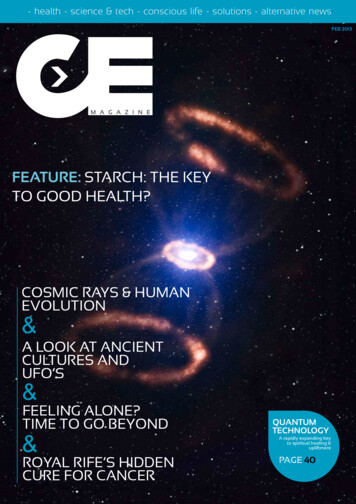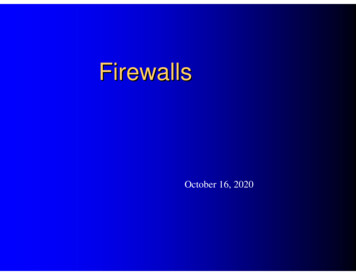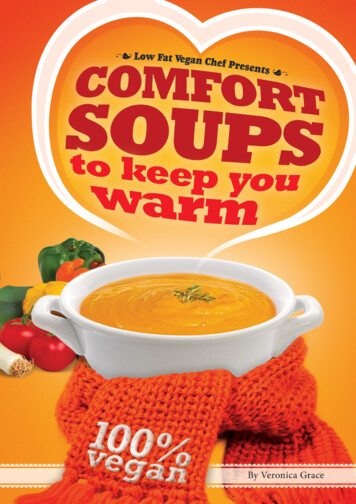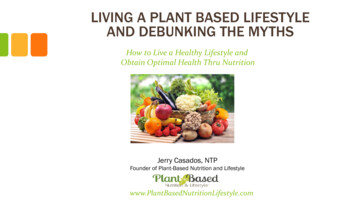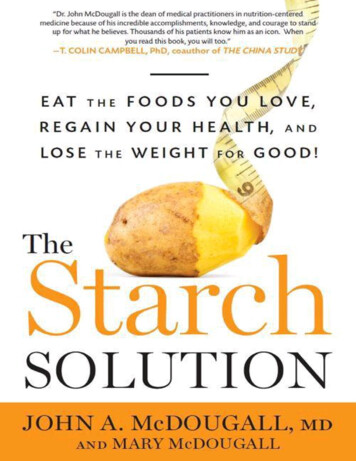
Transcription
“John McDougall, MD, has once again produced an outstanding book with recommendations gleaned from his decades of medical experience andstrongly supported by the scientific literature. He has the courage to tell the truth about both the business of medicine, which largely ignores the roleof diet, and the forces of evil that sell the promises of fractionated foods and diet fads. The information in this book can provide the reader thepower needed to lose weight and regain health.”—Alan Goldhamer, DC, director of TrueNorth Health Center and coauthor of The Pleasure Trap“The Starch Solution is one of the most important books ever written on healthy eating. As Dr. McDougall shows us in his book, human beingsflourish on starch foods from whole food sources. When combined with healthy servings of vegetables and fruits, we have the perfect diet to preventand reverse the lifestyle diseases that are now killing 80 percent of Americans—obesity, heart disease, strokes, diabetes, and cancer. The recipesincluded in the book are easy and delicious. The Starch Solution will change your life. Read it and live it.”—John P. Mackey, co-chief executive officer and director of Whole Foods Market, Inc.“This maverick physician has a wealth of knowledge that could be the key to a tremendous improvement. I personally know many people who havefound the McDougall program to be the key to vastly improved health for themselves and their families. This book lays it out clearly and withoutcompromise.”—John Robbins, author of No Happy Cows, The Food Revolution, and Diet for a New America“This time the Star McDougaller is John himself, joining with Mary in creating a masterfully crafted nutrition guide that destroys harmful myths andenhances the enduring capacity of whole food plant based nutrition as the foundation to our long overdue health revolution.”—Caldwell B. Esselstyn, Jr., MD, author of Prevent and Reverse Heart Disease“‘Eat all you want; any time you want.’ Statements that sound too good to be true usually are too good to be true. But John McDougall’s new bookThe Starch Solution, richly referenced for science, but gracefully written for consumers, just might be both good and true.”—George D. Lundberg MD, editor-at-large of MedPage Today“Great news! Thank you John! Now we can eat carbs guilt-free and maintain our figures.”—Elizabeth Kucinich, director of public affairs for the Physicians Committee for Responsible Medicine (PCRM)“John McDougall has done it again. This time, clarifying the issue of starches and the important role they play in human nutrition, improving ourhealth and the health of the planet.”—Jeff Novick, RD, vice president for Executive Health Exams International and lecturer at the McDougall Program
To our grandchildren—may the Starch Solution brighten your futures.
CONTENTSACKNOWLEDGMENTSNOTE TO THE READERPREFACEINTRODUCTION: MY PERSONAL JOURNEY TO THE STARCH SOLUTIONPart I: Healing with StarchChapter 1. Starch: The Traditional Diet of PeopleChapter 2. People Passionate about Starches Are Healthy and BeautifulChapter 3. Five Major Poisons Found in Animal FoodsChapter 4. Spontaneous Healing on a Starch-Based DietChapter 5. The USDA and the Politics of StarchChapter 6. We Are Eating the Planet to DeathPart II: The FAQs about FoodChapter 7. When Friends Ask: Where Do You Get Your Protein?Chapter 8. When Friends Ask: Where Do You Get Your Calcium?Chapter 9. Confessions of a Fish KillerChapter 10. The Fat VeganChapter 11. Just to Be on the Safe Side: Stay Away from SupplementsChapter 12. Salt and Sugar: The Scapegoats of the Western DietPart III: Living the SolutionChapter 13. Practicing the Starch SolutionChapter 14. The 7-Day Sure-Start PlanChapter 15. Our Favorite RecipesStarting the DaySaladsDressings, Sauces, and CondimentsBurgers and WrapsSoups and StewsMain DishesOn the SideSweet EndingsRESOURCESREFERENCESINDEX
ACKNOWLEDGMENTSThe Starch Solution is the result of 44 years of personal care of thousands of patients, most of whom once suffered from dietary diseases. Fromthese people we have learned our most valuable lessons. Many medical and nutritional pioneers, including Russell Henry Chittenden, PhD; HaroldPercival Himsworth, KCB; William Rose, PhD; Walter Kempner, MD; Denis Burkitt, FRS; Nathan Pritikin, and Roy Swank, MD, laid the scientificfoundations for the materials in this book.Our grateful appreciation to:Carole Bidnick, literary agent, for securing a powerful publisher.Shannon Welch, Ursula Cary, Marie Crousillat, and Marilyn Hauptly for editing for success.Cathy Fisher and Jennie Schacht for their help with writing.Lisa Kahn for crafting the illustrations.Star McDougallers for sharing their stories.McDougall followers for contributing ideas and recipes.The National Library of Medicine for providing access to the basic science.
NOTE TO THE READERDiet is powerful medicine. Do not change your diet or start an exercise program if you are seriously ill or on medications unless you are under thewatchful guidance of a health care provider knowledgeable about nutrition and its effects on health and about the medications you are taking. Thepeople in this book are real and their names are used with their permission. If you do as they have done, you should expect similar results. Althoughno treatment gives ideal outcomes for everyone, in most cases the Starch Solution provides an opportunity to remain free from common illnessesand to regain health and appearance. (Benefits with cancer recovery are real, but less common and well established.)The McDougall Diet is based on starches with the addition of fruits and vegetables. If you follow this low-fat vegan plan strictly for more than 3years, or if you are pregnant or nursing, then take a minimum of 5 micrograms of supplemental vitamin B12 daily.CONTACT INFORMATIONDr. McDougall’s Health and Medical CenterPO Box 14039Santa Rosa, CA 95402Telephone: (707) 538-8609 Fax: (707) 538-0712E-mail: drmcdougall@drmcdougall.comOn the Web: www.drmcdougall.comResidential programs: (800) 941-7111 / (707) 538-8609Book and DVD orders: www.drmcdougall.com/books tapes.html
PREFACEStarch has unlocked the door to good health for thousands of my patients over the last four decades, allowing them to lose excess weight and healfrom diet-related illnesses, like high blood pressure, heart disease, diabetes, and inflammatory arthritis. More than 5,000 people have taken part inthe McDougall residential programs, the vast majority forever altering the course of their lives. One and a half million others have purchased myprevious 11 books. The longer I practice medicine, the more crystal clear the solution becomes.The Starch Solution shares what I have learned and teaches what you can and must do to regain control of your health and appearance. Withintuitive information backed by scientific proof, an easy-to-follow plan, and nearly 100 simple and satisfying recipes to pave the way, The StarchSolution shows you how to reclaim your life, all by enjoying your favorite foods.Whatever you are doing now is not working. That’s why you’ve picked up this book. Most likely, you’ve tried other diets—probably many ofthem—but they have failed you. That’s because most diets make losing weight easy if you stick with them—but because they ask you to suffer a lifeof deprivation, or make you feel ill, they are not sustainable. Instead, you lose weight, then you lose interest, quickly gaining all the weight back andmore.The Starch Solution is different because it offers a way of eating that keeps you feeling satisfied. You won’t feel hungry or deprived, becausestarches are not only healthy, they’re also comforting and filling. This is a plan you can follow indefinitely—even when you stray by not following it100 percent—and its benefits will be with you for a lifetime. In other words, this is not an all-or-nothing approach.Beyond shedding excess weight almost effortlessly, you will look better, feel better, function better, and live better. For the majority of people,blood pressure and cholesterol will drop and digestion will finally work the way it should. In most cases, you will be able to get off and stay offprescription and nonprescription medications and supplements, saving a bundle and enjoying good health naturally. Once you try it and see theresults, you will know for certain that the Starch Solution is the answer you have been searching for your whole life. If you wish, skip ahead to test theplan yourself by using the 7-Day Sure-Start Plan in Chapter 14, while you continue to read and learn how and why the Starch Solution works.You will have questions along the way, but fear not; I have heard most of them before and I have answered them here for you. You needn’t worryabout getting sufficient protein, calcium, vitamins, or other nutrients. These ingredients are naturally built into the foods. With an informed mind youwill be able to evaluate health claims in product advertising, diet books, and public health messages. You will even learn why, if this approach holdssuch great promise, you have not heard this information before.As you read this book, you will come to understand that the very same solution that helps you also benefits the environment. With just a simpleU-turn in your diet to bring it back in line with healthier diets of long ago, you can help heal the world around you as you slim down, improve yourhealth, save money, and change your life.
INTRODUCTION
My Personal Journey to the Starch SolutionOne of my earliest life lessons was about honesty. As a child, I was a mischief magnet. I didn’t mean to be. I was just a curious kid. When I was 7,the police caught me “breaking and entering” into the vacant house across the street. I thought I was exploring. The following year, I killed my pethamster—it was an accident. At 9, I set the living room sofa on fire while conducting experiments with my dad’s cigarette lighter and lighter fluid. Iwas sorry about that. My parents were wise. They knew that punishment ran the risk of turning their well-intentioned little troublemaker into adisaffected, rebellious teen. They reasoned that the more I told them about my antics, the better chance they had of gently guiding my energiestoward more productive outlets. So, instead of yelling at me, they showed me that truth was the best way out of trouble. Finding and telling the truthhas been my credo ever since.I am a passionate person, with a larger-than-life, type A personality. I have lived with this high enthusiasm, for better or worse, every single dayof my life. I don’t just value truth, I seek it obsessively. At times, people find me brash, undiplomatic, and too direct. I can live with that. Speaking upis the single most effective way I know to awaken people from the falsehoods that are making them sick and teach the truths that can bring themhealth.That information is what I seek to share here, in The Starch Solution. What you will find on these pages is the truth about food, health,misinformation campaigns, and our planet. I’m laying it all out so that you may form your own opinions, and live your life fully aware of the impact ofwhat you eat on you, your family, and the world around you. Sharing what I have learned over the last 44 years of studying and practicing medicineis all I can do. The rest is up to you.
UNGUIDED WEALTH STOLE OUR HEALTHMy medical education started long before I became a doctor. At age 18, in 1965, I suffered a massive stroke that completely paralyzed my left sidefor 2 weeks. My recovery was slow and incomplete. Forty-seven years later, though I windsurf every day that I can, I still walk with a limp—a lifelongreminder of the path that led me to illness and then to newfound health.My parents lived through the Great Depression of the 1930s. During those hard times, my mother’s family survived on beans, corn, cabbage,parsnips, peas, rutabagas, carrots, onions, turnips, potatoes, and bread, which they bought for 5 cents a loaf. A little hamburger once a week wastheir only meat. My mother’s painful memories caused her to promise herself never to let her children suffer as she had. Her children would enjoythe best foods money could buy. Ironically, her well-intentioned promise ended up causing more harm than good. It turns out the Depression-eradiet was the healthier one!I grew up eating bacon and eggs for breakfast, sandwiches stuffed with meat and slathered with mayonnaise for lunch, and beef, pork, andchicken at the center of the plate every night at dinner. All three meals were washed down with glassfuls of milk. Starches? Those were side dishesat best (and covered with butter). Except in refined breads and cakes, they rarely found their way into our home.I didn’t realize it then, but the best food money could buy nearly killed me. As far back as I can remember, I suffered daily stomachaches andbrutal constipation. I was frequently sick with colds and flu, and when I was 7, out came my tonsils. I was always in last place in gym class, and myteenage face was oily and pocked with acne. At age 18 it became clear that something was terribly wrong when I suffered a stroke, something that Ithought happened only to old people. I had no idea this had any connection to my indulgent diet—nor did the doctors in the hospital suggestanything of the sort—so I kept on eating the very same way. By my early twenties I was 50 pounds overweight.I don’t blame my mother. She fed us based on the best nutritional advice available at the time. Who knew that much of this advice came fromthe meat and dairy industries, which exalted protein and calcium as our most essential nutrient needs? Even as concerns began to surface aboutthe adverse effects of animal foods, they were largely dismissed by food industry—funded scientists as unimportant.I was raised in a lower-middle-class family in the suburbs of Detroit. My parents worshipped medical doctors as if they were exceptionalbeings possessing godlike qualities. I was just an ordinary person, at best; I never even dreamed of pursuing a career in medicine—at least untilmy fateful hospitalization for my stroke. My exalted view of doctors shifted radically during my 2 weeks between those hospital walls. I became amedical curiosity, attracting some of the area’s top specialists to look in on me and review my case. As a patient, and a teenager eager to return toschool, I asked each doctor who examined me, “What caused my stroke?” “How will you make me better?” “When can I go home?”The typical response was nonverbal. They shook their heads and walked out of my room. I remember thinking to myself, “Well, I could do that.”When it became clear to me that no doctor could answer even one of my three basic questions, I walked out of the hospital against medical advice.Returning to college at Michigan State University, I felt for the first time a fierce sense of direction and determination. I entered medical school in1968 and pursued medicine with a great passion.I also became passionate about a surgical nurse I met during my senior year in medical school as I assisted with a hip replacement. Mary and Imarried and escaped to Hawaii, where I took my first year of post—medical school residency training, my internship, at The Queen’s MedicalCenter in Honolulu. Over the next 3 years I worked as a general practitioner at the Hamakua Sugar Company on the Big Island. There, as a generaldoctor to 5,000 sugar laborers and their families, I delivered babies, signed death certificates, and did everything in between. The nearestspecialist was a 42-mile drive away to Hilo. My patients were relying on me to do it all.When I treated acute problems, like sewing up injuries suffered in the fields, casting broken bones, or dispensing antibiotics for infections, Ienjoyed the satisfaction of seeing my patients heal. What frustrated me were the chronic problems. Despite my best efforts, I simply could not helppatients suffering from devastating illnesses like obesity, diabetes, heart disease, or arthritis. When a plantation worker came to me with one ofthese complaints, I would do the only thing I was taught in school: prescribe medications. As they walked out the door, I would invite my patients toreturn if the pill I gave them didn’t work. They would return. We’d try another pill. I never ran out of pills to try, but eventually the patient would stopcoming.Convinced that my failure resulted from my own shortcomings, after 3 years on the sugar plantation I left the Big Island of Hawaii, returned toHonolulu, and enrolled in the University of Hawaii Medical Residency Program. A little more than 2 years later, I left this intensive trainingexperience still wanting answers to the same questions I entered with. I did learn one valuable lesson: It might not be my fault after all that mypatients’ health did not improve. Even some of the world’s top medical scholars got no better results than I did. Like mine, their patients remainedriddled with chronic disease; at best, a few of my peers temporarily controlled symptoms.I graduated, took an exam, and received my board certification in internal medicine. But neither study nor that designation made me a gooddoctor. For that, I had to think back to my time on the plantation.
MORE LESSONS FROM MY PATIENTSPeople, including doctors, have an expectation that we will get fatter and sicker as we age. Children are the healthiest, their parents less healthy,and the eldest generation suffers from severe and chronic diseases.What happened with my patients on the sugar plantation challenged that expectation. There, the elderly immigrant generation remained trim,active, and medication free into their nineties. They had no diabetes, no heart disease, no arthritis, and no cancers of the breast, prostate, or colon.Their children were a little heavier and not as healthy. But what really threw me was seeing the youngest generation—the grandchildren of theseimmigrant families—suffering from the most profound health problems, the same ones I had spent my years learning about during my medicaltraining.What could be causing this reversal of fortune? I took a careful look at the way these families lived. I considered their lifestyles, the workenvironment on the plantation in Hawaii, and their behaviors. After considering every aspect of their lives, I noticed an interesting trend. Thesefamilies had gone from a traditional diet in their countries of origin to fully adopting an American diet. Had they lost the protection from obesity andcommon chronic diseases afforded by their native foods?My elderly patients on the plantation had immigrated to Hawaii from China, Japan, Korea, and the Philippines, where rice and vegetables hadbeen the foundation of their diet. They continued to eat the same way in their new American homes. The second generation, their Hawaiian-bornoffspring, began to incorporate Western foods into their parents’ traditional diet. The third generation cashed in the life-sustaining starch-based dietof their grandparents for a diet rich in meat, dairy, and processed foods.I grew up hearing the steadfast agreement among the government and every other source that the healthiest diet was a well-balanced one,taken from the four food groups: meat, dairy, grains, and fruits and vegetables. Yet on the plantation I watched elders thriving late into their senioryears sustained by grains and produce—just two of the four food groups—while each successive generation got sicker and sicker as theyincreased their reliance on the other two groups—meat and dairy.Over and over again, I saw this shift in diet over two, three, and four generations, and its reflection in my patients’ declining health. Finally,something shifted in me as I awakened from the false promises of my medical education. My patients brought me the insight I had been searchingfor since age 18, when I was hit by that awful stroke and could not get answers to the most basic questions about what might have caused it andwhat those doctors planned to do to improve my health going forward.My medical training had taught me nothing about the impact of food on health. Nutrition was almost never mentioned in medical school, mytextbooks, or during my internship or residency. There were very few questions about it on my board exam. Yet it was this one simple insight thatnow allows me to take patients off ineffective pills, protect them from risky surgeries, and offer them a simple, effective pathway to health andlongevity and permanent loss of excess body weight.
A WORLDWIDE PHENOMENONWondering whether this trend might apply beyond this small population in Hawaii, I began looking into traditional diets around the world. What Ilearned on the plantation was confirmed, over and over again. Diet was, indeed, the missing ingredient—and the most fundamental one—in humanhealth.The full potential of practicing dietary medicine became apparent only after I did additional research into what was known about the effects ofdiet on health. Sifting through stacks of scientific journals in the Hawaii Medical Library at The Queen’s Medical Center, I learned I wasn’t the firstphysician or scientist to come upon this discovery of a starch-based diet’s potential for healing. Others before me had found that potatoes, corn,and whole grains led to robust health, while meat and dairy led to persistent, life-threatening diseases.I also learned through those medical journals that people already sickened by disease could reverse the processes and recover, simply by nolonger eating the foods that made them sick and instead supporting their natural healing processes with a starch-based diet. There wasn’t just onelonely article saying so; study after study described weight loss, as well as the relief of chest pain, headaches, and arthritis, owing to a change inwhat people ate. Kidney disease, heart failure, type 2 diabetes, intestinal distress, asthma, obesity, and other troubles were also reversed byhealthy eating. Volumes of research in these journal pages written over the previous 50 years showed me how my patients, with their chronic,seemingly intractable conditions, could be cured with one simple solution: a diet based on starch supplemented by vegetables and fruits. No pills orsurgery needed.I could hardly wait to share the discovery that what I had observed on the plantation—a simple change in diet to improve health and relievemuch suffering—was already scientifically documented. I was certain my revolutionary breakthrough would be widely welcomed, that some flukehad prevented others from seeing this truth and shouting it out to a world of people eager to heal themselves from pain and suffering.
THE MCDOUGALL RESIDENTIAL PROGRAMSOver time, I tested, documented, and systematized my plant-food, starch-based therapy into the McDougall Program. When St. Helena Hospital inCalifornia’s Napa Valley asked me to implement it into their lifestyle residential program in 1986, I accepted. Their Seventh-Day Adventist faith,which endorses a vegetarian diet and a healthy lifestyle, seemed like a good match.Working at St. Helena Hospital, one of the nation’s leading heart surgery centers, gave me lots of exposure to surgeons and cardiologists. Ioffered to send these specialists my patients for a second opinion if they would reciprocate by sending me theirs. However, in my 16 years at St.Helena Hospital, though I referred many patients out for a second opinion or for other types of treatment, I never once received a referral from oneof these doctors. Interestingly, when I occasionally cared for the hospital’s own physicians, or their spouses or children, they commended myprotocols. They just didn’t seem to want the same simple, sensible treatments for their patients.Still, I knew my approach was working: The radiologists assured me of this as they monitored my patients’ repeat angiograms. They reportedthat their arteries were opening up and healing. This was all the reinforcement I needed.Over my years there, I saw thousands of people helped by St. Helena Hospital’s talented and caring staff. My lifestyle residential program,however, never flourished, even as my best-selling books, along with top television and radio programs, brought us international exposure. Maybe ahospital was not the best venue for a program focused on achieving health through diet rather than through a traditional medical approach. At 4,000 for my primarily educational program compared with 100,000 for bypass surgery, perhaps it just wasn’t bringing in enough revenue for thehospital.The opportunity to improve my census came when Dr. Roy Swank, the former head of neurology at Oregon Health & Science University whodesigned a dietary treatment for multiple sclerosis (MS), invited me to open up my live-in McDougall Program to treat patients with MS at St.Helena Hospital. I anticipated an enthusiastic response from the hospital administration, but after lengthy discussions, they decided thatassociating themselves with MS patients might stigmatize the hospital since these patients never seemed to get better. I also wondered whetherthe limited opportunity for profit might have been a consideration.When my contract came up for renewal in 2002, I turned it in with VOID written over the front page. I was told later that they had thought that Iwould not be able to leave them, because without the organization they provided, the McDougall Program could not exist. But I had run theMcDougall Program without them in Minneapolis for the Blue Cross/Blue Shield insurance company, where we demonstrated the same remarkableresults that we had experienced at St. Helena Hospital: reduced weight, cholesterol, blood pressure, and blood sugar levels, as well as relief fromindigestion, constipation, arthritis, and other ailments. That program also showed a 44 percent reduction in health care costs in 1 year based on theinsurance company’s own claims data. I’d done the same thing for Publix Supermarket employees in Lakeland, Florida. In both cases, we ran theprogram out of a local hotel. I knew I could easily set up a 10-day McDougall Program in any US city within 72 hours. All I needed were my staff,space, patients, and a kitchen that could prepare food the way I wanted it. The hospital’s nudge out its door was the best win yet, both for me andfor my patients.May 2002 marked our first McDougall Program at an upscale resort in Santa Rosa, California. By this time my wife, Mary, had developed anenormous repertoire of enticing recipes reflecting the program’s philosophy that would satisfy the appetites of our patients. Mary’s recipes are easyto prepare, not only in a professional kitchen, but also at home. (Nearly 100 of our favorites are included in Chapter 15.) The resort’s kitchen quicklylearned to turn out copious quantities of food that tasted good while nurturing our participants’ health and well-being.
MCDOUGALL’S MEDICINE USING THE STARCH SOLUTIONI have often been asked, “You are a doctor, so why do you speak against the practices of fellow physicians?” The answer is simple: I never took anoath to protect the financial interests of the medical industry. I did, however, take an oath to care for the sick and to keep them from harm andinjustice, and to never give a deadly drug or procedure. I fully realize that the views I advocate cause people with vested interests to dislike me. But Ican live with that unfairness. Too many physicians and dietitians pay allegiance to the big businesses of food and pharmaceuticals rather than totheir customers, the patients.Although I believe that most of my medical colleagues are well intentioned, their ignorance of basic human nutrition inhibits their ability to healtheir patients and protect them from harm. I understand this. I operated with this same colossal blind spot when I first practiced medicine, back onthe sugar plantation where I was frustrated by my powerlessness to perform the most elemental function of a physician: to help my patients regaintheir lost health and appearance. In 2011, I authored Senate Bill 380 for the state of California. This directive, passed unanimously by the legislatorsand signed by the governor, requires medical doctors to learn about human nutrition—a long overdue step forward for patients. These days,medical care is changing for the better because millions of informed people are demanding improved health rather than just more procedures andpills.The Starch Solution represents a giant step toward healing a sick system and putting easy, healthy choices within everyone’s reach, anddirectly into your own hands. In this book I share what I have learned over the past 44 years about promoting health and healing illness. To help youget started, I’ve included a 7-Day Sure-Start Plan in Chapter 14, backed up by practical information on how to ready your kitchen, your family, andyour life for this change in the way you eat. Chapter 15 gets the foods you love on the table with nearly 100 easy-to-prepare recipes to suit everytaste. Before long you will find yourself coming up with starch-centered meals effortlessly on your own. All you need to do to get started is turn thepage.
PART I
HEALING WITH STARCH
CHAPTER 1
Starch: The Traditional Diet of PeopleHave you had your rice today?This Chinese greeting—the equivalent of our how are you?—reminds us that, for the Chinese, whether you’ve eaten rice is the ultimatemeasure of well-being. Rice is that essential to the Chinese diet. Throughout most of Asia, the average person eats rice two to three times daily.Rice is also an important food in the Middle East, Latin America, Italy, and the West Indies. After corn it is the second most produced foodworldwide, and the world’s single most important source of energy, providing more than 20 percent of calories consumed by humans around theglobe.In China, the word for rice and food are one and the s
“The Starch Solution is one of the most important books ever written on healthy eating. As Dr. McDougall shows us in his book, human beings flourish on starch foods from whole food sources. When combined with healthy servings of v

